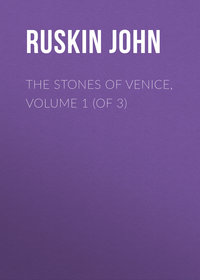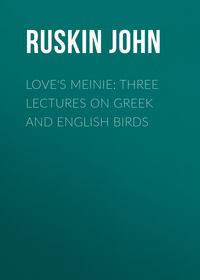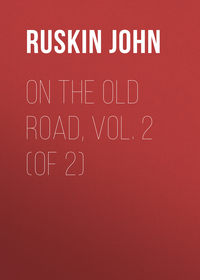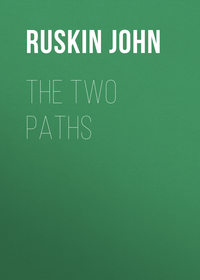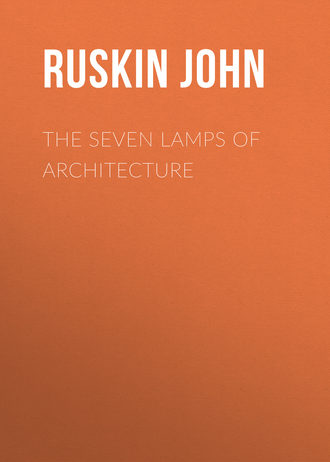 полная версия
полная версияThe Seven Lamps of Architecture
We have just spent, for instance, a hundred and fifty millions, with which we have paid men for digging ground from one place and depositing it in another. We have formed a large class of men, the railway navvies, especially reckless, unmanageable, and dangerous. We have maintained besides (let us state the benefits as fairly as possible) a number of iron founders in an unhealthy and painful employment; we have developed (this is at least good) a very large amount of mechanical ingenuity; and we have, in fine, attained the power of going fast from one place to another. Meantime we have had no mental interest or concern ourselves in the operations we have set on foot, but have been left to the usual vanities and cares of our existence. Suppose, on the other hand, that we had employed the same sums in building beautiful houses and churches. We should have maintained the same number of men, not in driving wheelbarrows, but in a distinctly technical, if not intellectual, employment, and those who were more intelligent among them would have been especially happy in that employment, as having room in it for the developement of their fancy, and being directed by it to that observation of beauty which, associated with the pursuit of natural science, at present forms the enjoyment of many of the more intelligent manufacturing operatives. Of mechanical ingenuity, there is, I imagine, at least as much required to build a cathedral as to cut a tunnel or contrive a locomotive: we should, therefore, have developed as much science, while the artistical element of intellect would have been added to the gain. Meantime we should ourselves have been made happier and wiser by the interest we should have taken in the work with which we were personally concerned; and when all was done, instead of the very doubtful advantage of the power of going fast from place to place, we should have had the certain advantage of increased pleasure in stopping at home.
IX. There are many other less capacious, but more constant, channels of expenditure, quite as disputable in their beneficial tendency; and we are, perhaps, hardly enough in the habit of inquiring, with respect to any particular form of luxury or any customary appliance of life, whether the kind of employment it gives to the operative or the dependant be as healthy and fitting an employment as we might otherwise provide for him. It is not enough to find men absolute subsistence; we should think of the manner of life which our demands necessitate; and endeavor, as far as may be, to make all our needs such as may, in the supply of them, raise, as well as feed, the poor. It is far better to give work which is above the men, than to educate the men to be above their work. It may be doubted, for instance, whether the habits of luxury, which necessitate a large train of men servants, be a wholesome form of expenditure; and more, whether the pursuits which have a tendency to enlarge the class of the jockey and the groom be a philanthropic form of mental occupation. So again, consider the large number of men whose lives are employed by civilized nations in cutting facets upon jewels. There is much dexterity of hand, patience, and ingenuity thus bestowed, which are simply burned out in the blaze of the tiara, without, so far as I see, bestowing any pleasure upon those who wear or who behold, at all compensatory for the loss of life and mental power which are involved in the employment of the workman. He would be far more healthily and happily sustained by being set to carve stone; certain qualities of his mind, for which there is no room in his present occupation, would develope themselves in the nobler; and I believe that most women would, in the end, prefer the pleasure of having built a church, or contributed to the adornment of a cathedral, to the pride of bearing a certain quantity of adamant on their foreheads.
X. I could pursue this subject willingly, but I have some strange notions about it which it is perhaps wiser not loosely to set down. I content myself with finally reasserting, what has been throughout the burden of the preceding pages, that whatever rank, or whatever importance, may be attributed or attached to their immediate subject, there is at least some value in the analogies with which its pursuit has presented us, and some instruction in the frequent reference of its commonest necessities to the mighty laws, in the sense and scope of which all men are Builders, whom every hour sees laying the stubble or the stone.
I have paused, not once nor twice, as I wrote, and often have checked the course of what might otherwise have been importunate persuasion, as the thought has crossed me, how soon all Architecture may be vain, except that which is not made with hands. There is something ominous in the light which has enabled us to look back with disdain upon the ages among whose lovely vestiges we have been wandering. I could smile when I hear the hopeful exultation of many, at the new reach of worldly science, and vigor of worldly effort; as if we were again at the beginning of days. There is thunder on the horizon as well as dawn. The sun was risen upon the earth when Lot entered into Zoar.
NOTES
Note I
Page 21.
"With the idolatrous Egyptian."The probability is indeed slight in comparison, but it is a probability nevertheless, and one which is daily on the increase. I trust that I may not be thought to underrate the danger of such sympathy, though I speak lightly of the chance of it. I have confidence in the central religious body of the English and Scottish people, as being not only untainted with Romanism, but immoveably adverse to it: and, however strangely and swiftly the heresy of the Protestant and victory of the Papist may seem to be extending among us, I feel assured that there are barriers in the living faith of this nation which neither can overpass. Yet this confidence is only in the ultimate faithfulness of a few, not in the security of the nation from the sin and the punishment of partial apostasy. Both have, indeed, in some sort, been committed and suffered already; and, in expressing my belief of the close connection of the distress and burden which the mass of the people at present sustain, with the encouragement which, in various directions, has been given to the Papist, do not let me be called superstitious or irrational. No man was ever more inclined than I, both by natural disposition and by many ties of early association, to a sympathy with the principles and forms of the Romanist Church; and there is much in its discipline which conscientiously, as well as sympathetically, I could love and advocate. But, in confessing this strength of affectionate prejudice, surely I vindicate more respect for my firmly expressed belief, that the entire doctrine and system of that Church is in the fullest sense anti-Christian; that its lying and idolatrous Power is the darkest plague that ever held commission to hurt the Earth; that all those yearnings for unity and fellowship, and common obedience, which have been the root of our late heresies, are as false in their grounds as fatal in their termination; that we never can have the remotest fellowship with the utterers of that fearful Falsehood, and live; that we have nothing to look to from them but treacherous hostility; and that, exactly in proportion to the sternness of our separation from them, will be not only the spiritual but the temporal blessings granted by God to this country. How close has been the correspondence hitherto between the degree of resistance to Romanism marked in our national acts, and the honor with which those acts have been crowned, has been sufficiently proved in a short essay by a writer whose investigations into the influence of Religion upon the fate of Nations have been singularly earnest and successful—a writer with whom I faithfully and firmly believe that England will never be prosperous again, and that the honor of her arms will be tarnished, and her commerce blighted, and her national character degraded, until the Romanist is expelled from the place which has impiously been conceded to him among her legislators. "Whatever be the lot of those to whom error is an inheritance, woe be to the man and the people to whom it is an adoption. If England, free above all other nations, sustained amidst the trials which have covered Europe, before her eyes, with burning and slaughter, and enlightened by the fullest knowledge of divine truth, shall refuse fidelity to the compact by which those matchless privileges have been given, her condemnation will not linger. She has already made one step full of danger. She has committed the capital error of mistaking that for a purely political question which was a purely religious one. Her foot already hangs over the edge of the precipice. It must be retracted, or the empire is but a name. In the clouds and darkness which seem to be deepening on all human policy—in the gathering tumults of Europe, and the feverish discontents at home—it may be even difficult to discern where the power yet lives to erect the fallen majesty of the constitution once more. But there are mighty means in sincerity; and if no miracle was ever wrought for the faithless and despairing, the country that will help itself will never be left destitute of the help of Heaven" (Historical Essays, by the Rev. Dr. Croly, 1842). The first of these essays, "England the Fortress of Christianity," I most earnestly recommend to the meditation of those who doubt that a special punishment is inflicted by the Deity upon all national crime, and perhaps, of all such crime most instantly upon the betrayal on the part of England of the truth and faith with which she has been entrusted.
Note II
Page 25.
"Not the gift, but the giving."Much attention has lately been directed to the subject of religious art, and we are now in possession of all kinds of interpretations and classifications of it, and of the leading facts of its history. But the greatest question of all connected with it remains entirely unanswered, What good did it do to real religion? There is no subject into which I should so much rejoice to see a serious and conscientious inquiry instituted as this; an inquiry neither undertaken in artistical enthusiasm nor in monkish sympathy, but dogged, merciless and fearless. I love the religious art of Italy as well as most men, but there is a wide difference between loving it as a manifestation of individual feeling, and looking to it as an instrument of popular benefit. I have not knowledge enough to form even the shadow of an opinion on this latter point, and I should be most grateful to any one who would put it in my power to do so. There are, as it seems to me, three distinct questions to be considered: the first, What has been the effect of external splendor on the genuineness and earnestness of Christian worship? the second, What the use of pictorial or sculptural representation in the communication of Christian historical knowledge, or excitement of affectionate imagination? the third, What the influence of the practice of religious art on the life of the artist?
In answering these inquiries, we should have to consider separately every collateral influence and circumstance; and, by a most subtle analysis, to eliminate the real effect of art from the effects of the abuses with which it was associated. This could be done only by a Christian; not a man who would fall in love with a sweet color or sweet expression, but who would look for true faith and consistent life as the object of all. It never has been done yet, and the question remains a subject of vain and endless contention between parties of opposite prejudices and temperaments.
Note III
Page 26.
"To the concealment of what is really good or great."I have often been surprised at the supposition that Romanism, In its present condition, could either patronise art or profit by it. The noble painted windows of St. Maclou at Rouen, and many other churches in France, are entirely blocked up behind the altars by the erection of huge gilded wooden sunbeams, with interspersed cherubs.
Note IV
Page 33.
"With different pattern of traceries in each."I have certainly not examined the seven hundred and four traceries (four to each niche) so as to be sure that none are alike; but they have the aspect of continual variation, and even the roses of the pendants of the small groined niche roofs are all of different patterns.
Note V
Page 43.
"Its flamboyant traceries of the last and most degraded forms."They are noticed by Mr. Whewell as forming the figure of the fleur-de-lis, always a mark, when in tracery bars, of the most debased flamboyant. It occurs in the central tower of Bayeux, very richly in the buttresses of St. Gervais at Falaise, and in the small niches of some of the domestic buildings at Rouen. Nor is it only the tower of St. Ouen which is overrated. Its nave is a base imitation, in the flamboyant period, of an early Gothic arrangement; the niches on its piers are barbarisms; there is a huge square shaft run through the ceiling of the aisles to support the nave piers, the ugliest excrescence I ever saw on a Gothic building; the traceries of the nave are the most insipid and faded flamboyant; those of the transept clerestory present a singularly distorted condition of perpendicular; even the elaborate door of the south transept is, for its fine period, extravagant and almost grotesque in its foliation and pendants. There is nothing truly fine in the church but the choir, the light triforium, and tall clerestory, the circle of Eastern chapels, the details of sculpture, and the general lightness of proportion; these merits being seen to the utmost advantage by the freedom of the body of the church from all incumbrance.
Note VI
Page 43.
Compare Iliad Σ. 1. 219 with Odyssey Ω. 1. 5—10.
Note VII
Page 44.
"Does not admit iron as a constructive material."Except in Chaucer's noble temple of Mars."And dounward from an hill under a bent,Ther stood the temple of Mars, armipotent,Wrought all of burned stele, of which th' entreeWas longe and streite, and gastly for to see.And thereout came a rage and swiche a vise,That it made all the gates for to rise.The northern light in at the dore shone,For window on the wall ne was ther none,Thurgh which men mighten any light discerneThe dore was all of athamant eterne,Yclenched overthwart and ende longWith yren tough, and for to make it strong,Every piler the temple to susteneWas tonne-gret, of yren bright and shene."The Knighte's Tale.There is, by the bye, an exquisite piece of architectural color just before:
"And northward, in a turret on the wallOf alabaster white, and red corall,An oratorie riche for to see,In worship of Diane of Chastitee."Note VIII
Page 44.
"The Builders of Salisbury.""This way of tying walls together with iron, instead of making them of that substance and form, that they shall naturally poise themselves upon their buttment, is against the rules of good architecture, not only because iron is corruptible by rust, but because it is fallacious, having unequal veins in the metal, some places of the same bar being three times stronger than others, and yet all sound to appearance." Survey of Salisbury Cathedral in 1668, by Sir C. Wren. For my own part, I think it better work to bind a tower with iron, than to support a false dome by a brick pyramid.
Note IX
Page 60.
Plate IIIIn this plate, figures 4, 5, and 6, are glazed windows, but fig. 2 is the open light of a belfry tower, and figures 1 and 3 are in triforia, the latter also occurring filled, on the central tower of Coutances.
Note X
Page 94.
"Ornaments of the transept towers of Rouen."The reader cannot but observe agreeableness, as a mere arrangement of shade, which especially belongs to the "sacred trefoil." I do not think that the element of foliation has been enough insisted upon in its intimate relations with the power of Gothic work. If I were asked what was the most distinctive feature of its perfect style, I should say the Trefoil. It is the very soul of it; and I think the loveliest Gothic is always formed upon simple and bold tracings of it, taking place between the blank lancet arch on the one hand, and the overcharged cinquefoiled arch on the other.
Note XI
Page 95.
"And levelled cusps of stone."The plate represents one of the lateral windows of the third story of the Palazzo Foscari. It was drawn from the opposite side of the Grand Canal, and the lines of its traceries are therefore given as they appear in somewhat distant effect. It shows only segments of the characteristic quatrefoils of the central windows. I found by measurement their construction exceedingly simple. Four circles are drawn in contact within the large circle. Two tangential lines are then drawn to each opposite pair, enclosing the four circles in a hollow cross. An inner circle struck through the intersections of the circles by the tangents, truncates the cusps.
Note XII
Page 124.
"Into vertical equal parts."Not absolutely so. There are variations partly accidental (or at least compelled by the architect's effort to recover the vertical), between the sides of the stories; and the upper and lower story are taller than the rest. There is, however, an apparent equality between five out of the eight tiers.
Note XIII
Page 133.
"Never paint a column with vertical lines."It should be observed, however, that any pattern which gives opponent lines in its parts, may be arranged on lines parallel with the main structure. Thus, rows of diamonds, like spots on a snake's back, or the bones on a sturgeon, are exquisitely applied both to vertical and spiral columns. The loveliest instances of such decoration that I know, are the pillars of the cloister of St. John Lateran, lately illustrated by Mr. Digby Wyatt, in his most valuable and faithful work on antique mosaic.
Note XIV
Page 139.
On the cover of this volume the reader will find some figure outlines of the same period and character, from the floor of San Miniato at Florence. I have to thank its designer, Mr. W. Harry Rogers, for his intelligent arrangement of them, and graceful adaptation of the connecting arabesque. (Stamp on cloth cover of London edition.)
Note XV
Page 169.
"The flowers lost their light, the river its music."Yet not all their light, nor all their music. Compare Modern Painters, vol. ii. sec. 1. chap. iv. SECTION 8.
Note XVI
Page 181.
"By the artists of the time of Perides."This subordination was first remarked to me by a friend, whose profound knowledge of Greek art will not, I trust, be reserved always for the advantage of his friends only: Mr. C. Newton, of the British Museum.
Note XVII
Page 188.
"In one of the noblest poems."Coleridge's Ode to France:"Ye Clouds! that far above me float and pause,Whose pathless march no mortal may control!Ye Ocean-Waves! that wheresoe'er ye roll,Yield homage only to eternal laws!Ye Woods! that listen to the night-birds singing.Midway the smooth and perilous slope reclined,Save when your own imperious branches swinging,Have made a solemn music of the wind!Where, like a man beloved of God,Through glooms, which never woodman trod,How oft, pursuing fancies holy,My moonlight way o'er flowering weeds I wound,Inspired, beyond the guess of folly,By each rude shape and wild unconquerable sound!O ye loud Waves! and O ye Forests high!And O ye Clouds that far above me soared!Thou rising Sun! thou blue rejoicing Sky!Yea, everything that is and will be free!Bear witness for me, wheresoe'er ye be,With what deep worship I have still adoredThe spirit of divinest Liberty."Noble verse, but erring thought: contrast George Herbert:—
"Slight those who say amidst their sickly healths,Thou livest by rule. What doth not so but man?Houses are built by rule and Commonwealths.Entice the trusty sun, if that you can,From his ecliptic line; beckon the sky.Who lives by rule then, keeps good company."Who keeps no guard upon himself is slack,And rots to nothing at the next great thaw;Man is a shop of rules: a well-truss'd packWhose every parcel underwrites a law.Lose not thyself, nor give thy humors way;God gave them to thee under lock and key."1
The inordinate delay in the appearance of that supplementary volume has, indeed, been chiefly owing to the necessity under which the writer felt himself, of obtaining as many memoranda as possible of mediæval buildings in Italy and Normandy, now in process of destruction, before that destruction should be consummated by the Restorer or Revolutionist. His whole time has been lately occupied in taking drawings from one side of buildings, of which masons were knocking down the other; nor can he yet pledge himself to any time for the publication of the conclusion of "Modern Painters;" he can only promise that its delay shall not be owing to any indolence on his part.
2
2 Sam. xxiv. 24. Deut. xvi. 16, 17.
3
Mal. i. 8.
4
Lam. ii. 11. 2 Kings xvii. 25.
5
Num. xxxi. 54. Psa. lxxvi. 11.
6
John xii. 5.
7
Mod. Painters, Part I. Sec. 1, Chap. 3.
8
Henceforward, for the sake of convenience, when I name any cathedral town in this manner, let me be understood to speak of its cathedral church.
9
Literature of the Fine Arts.—Essay on Bas-relief.




